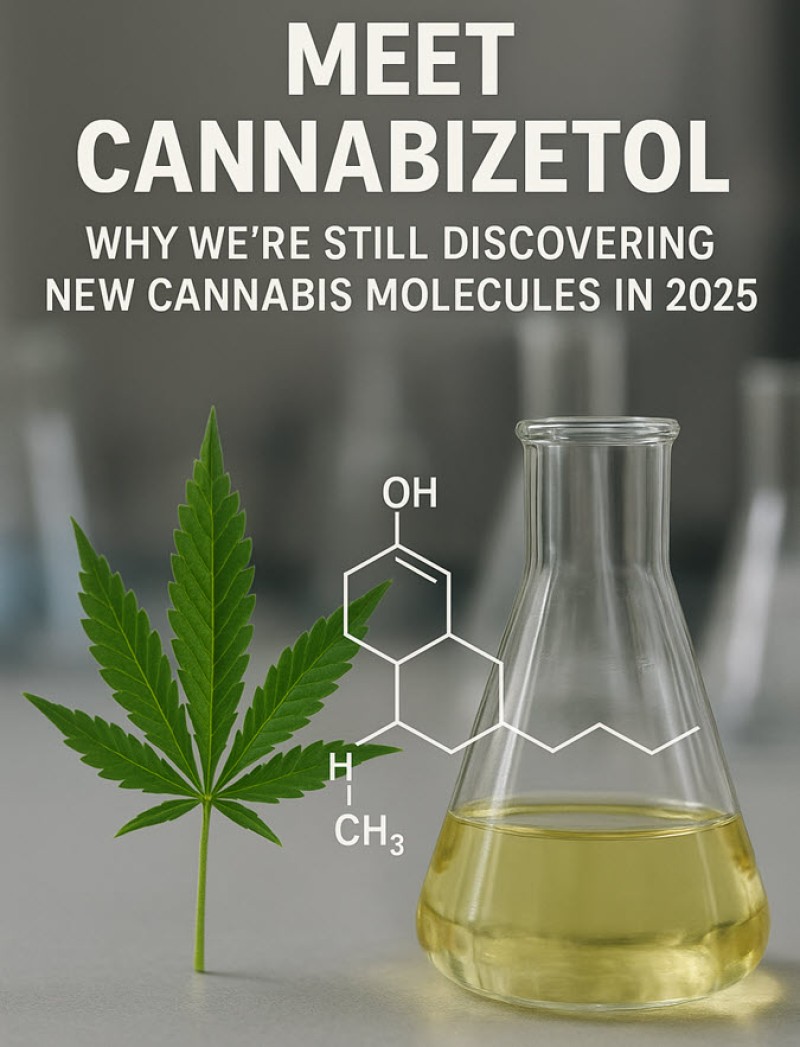
Here's what gets me fired up: in 2025, scientists from Italy and Switzerland just discovered an entirely new class of cannabis compound with remarkable anti-inflammatory and antioxidant properties. Not just another minor cannabinoid to add to our growing list—we're talking about a fundamentally different type of molecule called a dimeric cannabinoid, where two separate cannabinoid molecules fuse together to create something neither could do alone.
The compound is called cannabizetol (CBGD), and it's only the fourth dimeric cannabinoid ever identified in cannabis. When researchers tested it against 84 different inflammatory genes, it showed significantly higher anti-inflammatory activity than any previously studied dimeric cannabinoid. It works through the NF-κB pathway—essentially a master switch for inflammation throughout the human body—and exhibits powerful antioxidant properties that could have applications in dermatology, chronic inflammation, and potentially dozens of other medical conditions we haven't even imagined yet.
But here's the question that keeps me up at night: why are we only discovering compounds like this now? Cannabis has been used medicinally for thousands of years. We isolated THC back in 1964. We mapped the endocannabinoid system in the 1990s. It's 2025, and we're still finding entirely new categories of molecules?
The answer isn't that cannabis is infinitely complex, though it certainly is complex. The answer is that federal prohibition strangled cannabis research for over half a century, creating a knowledge gap so massive that we're still playing catch-up decades after we should have mapped this plant's full chemical potential.
Think about what we've accomplished in other fields with full research funding and institutional support. We sequenced the human genome. We landed rovers on Mars. We developed mRNA vaccines in record time. And yet cannabis—a plant that grows wild on every continent except Antarctica, that produces over 100 known cannabinoids and hundreds of terpenes, that interacts with a fundamental regulatory system in the human body—remains partially unmapped because the federal government decided it was too dangerous to study.
Cannabizetol isn't just a scientific curiosity. It's evidence of opportunity cost. Every compound we discover now represents decades of delayed research, missed medical applications, and therapeutic potential that could have helped millions of people. And here's the truly exciting part: if we're still finding new compound classes in 2025, imagine what we'd discover with full research funding, open institutional access, and the kind of scientific resources we devote to pharmaceuticals or agricultural development.
This is what drives my curiosity about cannabis: not just what we've found, but what we haven't looked for yet. And cannabizetol suggests we're not even close to the end of discovery.
The Frankenstein Molecule: When Two Cannabinoids Become One
Let me explain what makes cannabizetol genuinely fascinating from a chemical standpoint. Most cannabinoids we know—THC, CBD, CBG, CBN, and the rest—are monomeric molecules. They exist independently, synthesized through well-understood biochemical pathways starting with cannabigerolic acid (CBGA), which gets converted into various cannabinoids through specific enzymes.
Dimeric cannabinoids are different animals entirely. They form when two cannabinoid molecules—either identical or different types—bond together through a methylene bridge, creating a single new molecule with properties that neither possessed individually. It's not a mixture or a simple chemical reaction. It's molecular fusion that creates something with entirely new biological activity.
Only four dimeric cannabinoids have been identified in cannabis: cannabizetol (the new discovery), cannabitwinol, cannabitriol, and cannabiripsol. Four. In a plant that produces over 100 known cannabinoids. This rarity tells us something important: either these compounds form in minuscule quantities, they're chemically unstable and break down quickly, or—and I suspect this is the real answer—we simply haven't been looking for them properly.
The Italian and Swiss research team didn't extract cannabizetol from plant material. They synthesized it in the laboratory using flow chemistry technology, which allows precise control of chemical reactions. This is actually brilliant strategic thinking: by creating analytical standards in the lab, they're giving other researchers the tools to identify whether cannabizetol exists naturally in cannabis plants, and if so, under what conditions it forms.
When they tested cannabizetol's biological activity, they focused on inflammation and oxidative stress using human keratinocyte cells—skin cells. They created an experimental inflammation model, applied cannabizetol, and measured its effects on 84 genes associated with inflammatory responses.
The results were impressive enough to warrant publication in the Journal of Natural Products. Cannabizetol demonstrated "remarkable antioxidant and skin anti-inflammatory activity," significantly outperforming cannabitwinol across multiple inflammatory markers. It appeared to work primarily by modulating the NF-κB pathway, which is crucial for immune responses, inflammation, cell survival, and proliferation throughout the body.
Here's what makes this particularly intriguing: the biological activity wasn't simply additive. You couldn't predict cannabizetol's effects by just combining two monomeric cannabinoids. The methylene bridge fundamentally altered how the molecule interacts with biological systems, creating novel properties that emerge only from the dimeric structure.
The researchers note that "natural dimeric compounds are of considerable importance, as they enable further exploration of chemical space, potentially leading to novel biological activities beyond those of their respective monomers." In plain language: these fusion molecules might do things regular cannabinoids simply cannot do, opening entirely new therapeutic pathways we haven't explored yet.
And here's where my curiosity goes into overdrive: if cannabizetol shows this much promise, what about all the other possible dimeric combinations? What happens when THC molecules fuse? Or when CBG binds with CBD? Or when different cannabinoids combine in various configurations? The researchers explicitly suggest that "among the many still unknown cannabinoids there are also methylene-bridged dimers of other cannabinoids, including dimers composed of two different cannabinoids."
We could be looking at dozens, potentially hundreds of dimeric compounds with unique biological activities. Each one represents a potential medical application, an industrial use case, or an agricultural innovation we haven't conceived of yet. And we're only finding them now—not because they're recently evolved or newly present in the plant, but because we're finally able to look.
The Prohibition Tax: What Fifty Years of Stifled Research Cost Us
Let's talk about why cannabizetol matters beyond its specific properties. This discovery represents a broader indictment of federal prohibition's impact on scientific progress.
Raphael Mechoulam isolated THC in 1964—sixty-one years ago. That was groundbreaking work that should have triggered an explosion of cannabis research. Instead, the 1970 Controlled Substances Act classified cannabis as Schedule I, defined as having "no currently accepted medical use" and "a high potential for abuse." This classification made cannabis research extraordinarily difficult, expensive, and rare.
Researchers who wanted to study cannabis needed special DEA licenses. They could only access cannabis from a single government-approved source—the University of Mississippi—which grew limited varieties under controlled conditions that didn't represent the diversity of cannabis genetics available. Funding was nearly impossible to obtain; why would the NIH fund research on a plant the government declared had no medical value? Academic institutions were reluctant to support cannabis research due to federal restrictions and potential loss of other funding.
The result was a multi-decade knowledge blackout. While other fields advanced exponentially—pharmacology, genomics, agricultural science—cannabis research remained stuck in the 1960s. The scientists who might have mapped cannabis's full chemical complexity were studying other things. The funding that could have accelerated discovery went elsewhere. The institutional knowledge that accumulates through decades of sustained research never developed.
Consider what we accomplished in other fields during those same decades. We mapped the human genome through the Human Genome Project, identifying all 20,000+ genes and their functions. We developed targeted cancer therapies, understanding molecular pathways with extraordinary precision. We revolutionized agriculture through genetic modification and marker-assisted breeding. We created entire new fields of study—epigenetics, systems biology, synthetic biology.
And cannabis? We puttered along with a handful of dedicated researchers working with limited resources, restricted access, and minimal funding. It wasn't until state-level medical marijuana programs began in the late 1990s and early 2000s that research slowly started expanding. The 2018 Farm Bill, which legalized hemp production, finally opened the floodgates for more widespread research access. Full federal legalization still hasn't happened.
Now, in 2025, we're discovering dimeric cannabinoids and acting surprised that the plant still holds secrets. Of course it holds secrets. We've barely scratched the surface of systematic investigation.
Here's what we could have accomplished with fifty years of unrestricted research funding:
Medical applications: Complete characterization of every cannabinoid and terpene. Clinical trials for hundreds of conditions. Standardized dosing protocols. Understanding of drug interactions. Development of targeted therapies for specific receptors and pathways. We might have effective treatments for chronic pain, PTSD, epilepsy, inflammatory conditions, and neurodegenerative diseases that are currently in their infancy.
Agricultural applications: Breeding programs for specific cannabinoid profiles. Understanding of how growing conditions affect chemical composition (like the soil study we discussed previously). Development of disease-resistant varieties. Optimization of cultivation for sustainability and efficiency. Hemp varieties tailored for fiber, seed, or cannabinoid production. We could have an agricultural revolution comparable to what we did with corn or wheat.
Industrial applications: Full characterization of hemp fiber properties for construction materials, textiles, and plastics. Development of hemp-based biofuels. Understanding of carbon sequestration potential. Creation of biodegradable alternatives to petroleum-based products. We could have addressed climate change and plastic pollution using a renewable resource that was illegal to grow.
Pharmaceutical development: Isolation and synthesis of hundreds of minor cannabinoids and dimeric compounds. Understanding of which compounds work synergistically (the entourage effect). Development of novel therapeutics based on cannabis chemistry but optimized for specific medical applications. We could have an entire pharmacopeia of cannabis-derived medicines instead of essentially just Epidiolex.
The discovery of cannabizetol in 2025 is exciting because it opens new possibilities. But it's also frustrating because it represents decades of delay. How many other dimeric cannabinoids exist? When will we find them? How many medical applications have we missed because we couldn't study this plant freely?
The technology exists now. Modern liquid chromatography-mass spectrometry can detect compounds at parts per billion. High-resolution NMR spectroscopy can map three-dimensional molecular structures. Genetic sequencing and CRISPR gene editing allow precise breeding and even synthetic biology approaches. We have the tools to fully map cannabis's chemical complexity within a decade—if we commit the resources.
But we're still fighting federal prohibition, banking restrictions, research limitations, and institutional reluctance. Cannabizetol was discovered by researchers in Italy and Switzerland, not the United States, despite America's massive research infrastructure. We're letting other countries take the lead on understanding a plant that's been part of human culture for millennia.
The Sticky Bottom Line: The Future We Could Build
Let's bring this back to cannabizetol's practical potential while acknowledging where we actually stand in the research pipeline.
The most immediate application appears to be dermatological. Those "remarkable antioxidant and skin anti-inflammatory" properties could translate to treatments for psoriasis, eczema, rosacea, dermatitis, and inflammatory skin conditions affecting hundreds of millions of people globally. The antioxidant effects could address skin aging, UV damage, and oxidative stress. If cannabizetol can be formulated for topical application with good penetration and stability, we might be looking at a genuinely novel therapeutic class.
But—and this is crucial—we're talking about cell culture studies. Cannabizetol hasn't been tested in animals, let alone humans. We don't know about safety at therapeutic doses, potential side effects, drug interactions, or whether it can actually penetrate skin barriers effectively. We're years away from any consumer product, assuming everything goes perfectly through the research pipeline.
The broader anti-inflammatory properties intrigue me more. The NF-κB pathway that cannabizetol modulates is involved in inflammation throughout the body. Could this compound have applications in arthritis? Inflammatory bowel disease? Chronic pain? Neurodegenerative diseases with inflammatory components? Cardiovascular inflammation? The possibilities are extensive, but again, we're speculating based on preliminary cell studies.
What excites me most isn't cannabizetol specifically—it's what this discovery represents. If there are four known dimeric cannabinoids and one shows significant biological activity, what about all the other possible combinations? What happens when different cannabinoids fuse in various configurations? What about trimeric compounds, if those exist? We might be looking at an entirely new frontier of cannabis chemistry.
The researchers explicitly suggest this: "among the many still unknown cannabinoids there are also methylene-bridged dimers of other cannabinoids, including dimers composed of two different cannabinoids, with potential biological activities of great interest." Each unique dimer could have unique properties, unique medical applications, unique industrial uses.
This is the future I want to see: full-scale research programs exploring cannabis's complete chemical complexity. Not just cannabinoids, but terpenes, flavonoids, and whatever other compound classes we haven't identified yet. Not just medical applications, but agricultural optimization, industrial materials, environmental benefits, and economic opportunities.
Imagine what we could accomplish with the kind of research funding that goes into pharmaceutical development or agricultural science. Imagine if cannabis research received even a fraction of what we invest in corn or soybean research. We could map every compound, understand every biosynthetic pathway, identify every potential application, and develop targeted varieties for specific purposes.
We could breed cannabis varieties that produce high levels of specific dimeric cannabinoids for medical applications. We could optimize hemp for carbon sequestration and sustainable materials. We could develop standardized medical formulations with consistent effects. We could create an entire economy around cannabis innovation that goes far beyond recreational use or basic medical marijuana.
Cannabizetol is a reminder that prohibition didn't just harm people through arrests and incarceration—though that harm is immense and unconscionable. Prohibition also robbed us of knowledge, delayed medical progress, and prevented agricultural and industrial innovation that could have benefited millions.
We're discovering new cannabis compounds in 2025 not because the plant is infinitely mysterious, but because we're finally able to look. And what we're finding suggests we've only glimpsed the tip of the iceberg. The question isn't whether cannabis has more secrets to reveal—it obviously does. The question is whether we'll finally commit the resources to uncovering them, or whether we'll keep stumbling across discoveries decades later than we should have.
I'm choosing curiosity and optimism. Cannabizetol exists. Other dimeric cannabinoids exist. Undiscovered compounds exist. And with every discovery, we move one step closer to understanding the full potential of a plant we should have mapped fifty years ago. Better late than never, but let's stop wasting time.






